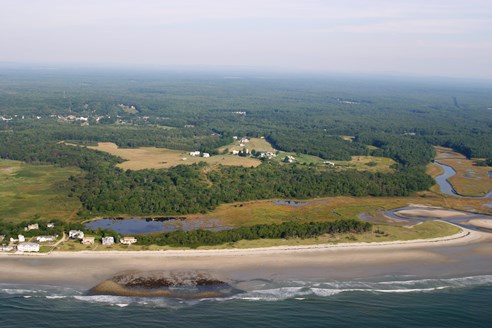The Wrack
The Wrack is the Wells Reserve blog, our collective logbook on the web.
The Wrack is the Wells Reserve blog, our collective logbook on the web.

The following was published in the Biddeford-Saco Journal Tribune Sunday edition, 9/20/2015, and Making It At Home newspaper.
To a man with a hammer, everything looks like a nail. To a man at a coastal research center during Maine Coast Week, all the world’s a coast.
Literally (littorally?), the coast is the region where land meets sea. Here we sit in Southern Maine, perched on the [above water] edge of the North American continent. Next stop, Portugal. The Latin costa, meaning side or rib, feels right for much of Maine. A bulwark against the great Atlantic, our hard bony edge is also our state’s primary economic engine and our most valuable tourist resource.
But is that our only coast? The Gulf of Maine washes onto the sandy beaches of York County, but mere dozens of miles “Down East” in Cape Elizabeth, a rocky shore takes over. We are not only on the coast between sea and land; latitudinally, we stand astride beaches of rock and sand.
A coast need not only be geological. As Dr. Andrew Barton from UMaine-Farmington describes in his fascinating book, “The Changing Nature of the Maine Woods,” an ocean of hardwood broadleaf trees is lapping at the coniferous shore of the Pine Tree State. To the north, the great boreal forest of spruce and fir stretches nearly a thousand miles to the Arctic tundra. To the south, oaks and hickories dominate the Eastern Seaboard. As Maine warms, these species are creeping northward, right through our backyards. In the Mount Agamenticus conservation region in York and Wells, you can find the only temperate hardwood forest in Maine. Our communities’ overlapping zones create the most biodiverse forest in the entire Northeast. Every local gardener already knows that we live in a sweet spot. Two of the USDA’s Plant Hardiness Zones, 5b and 6a, intermingle in York County. Peaches and nectarines, you are most welcome here.
Clearly, we live not just on the edges of space, but of time. Humans, as a species, have created another coast: the ocean of a new and different era is arriving. Due primarily to the greenhouse gases we have released into the atmosphere, the temperatures of tomorrow are headed back to high tide levels not seen for thousands of years. If that puts you in a pessimistic mood, play around with doomsday scenarios on NOAA’s Digital Coast Sea Level Rise Viewer. With the click of a few buttons, you can plunge our existing coast beneath the future’s waves and flood your friends for fun.
Optimistically, you can instead explore the plants available in southern climes that are on a steady march our way. With the unrelenting expansion of southern temperatures will come creeping ticks, emerald ash borers, new mosquito-borne viruses, yes, but also new flowers and fruits. Jersey tomatoes and Georgia pecans, anyone?
This is the century in which we’ll likely step off this island Earth for new planets. Like children on the shore, we’ve swum out to the dock of the Moon, but Mars and more await us over the horizon.
Today, we are living on the edge, standing on many coasts: in Maine, on earth, in time. Whichever coast you happen to find yourself on this week, take a moment to look around. These edges are dynamic, energetic, frothy places. Let’s raise a toast to all our coasts.
NOTE: The Wells Reserve at Laudholm hosts the Punkinfiddle Family Festival, an annual celebration of coasts and estuaries, this Saturday, September 26, from 10am to 4pm.
Nik Charov is president of Laudholm Trust, the nonprofit partner of the Wells National Estuarine Research Reserve in Wells, Maine. His Sunday column, “Between Two Worlds,” ventures forth from the intersection of art and science, past and future, land and sea. More at wellsreserve.org/twoworlds.